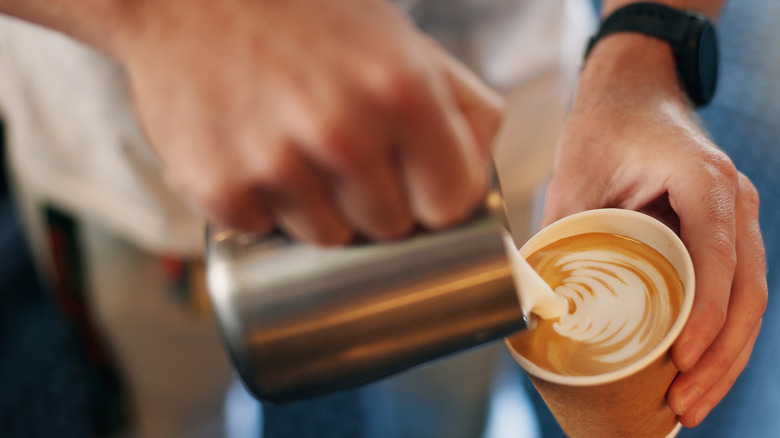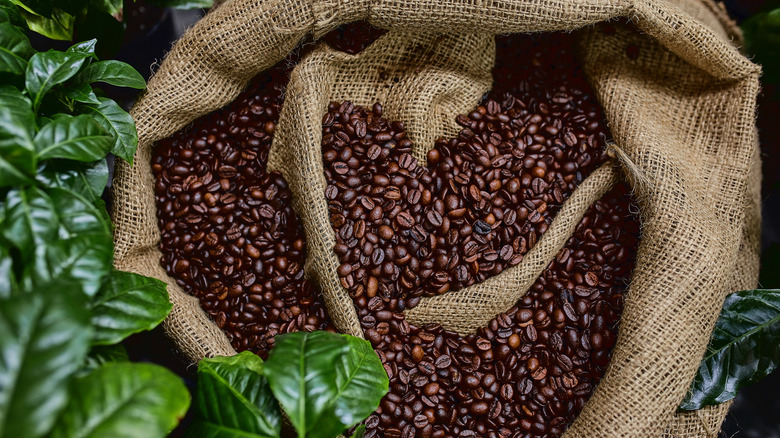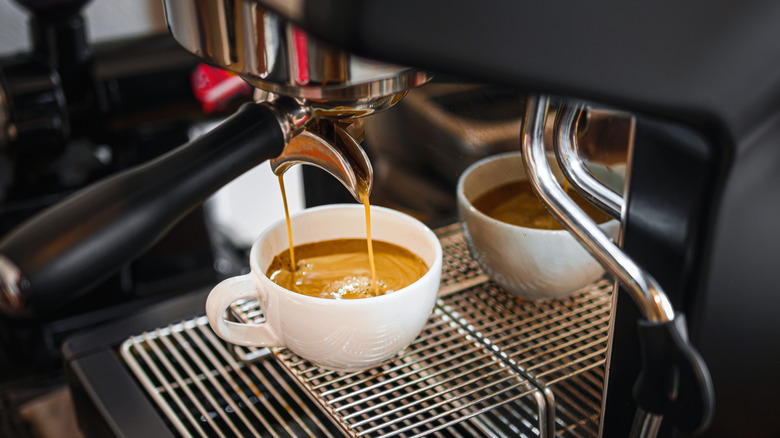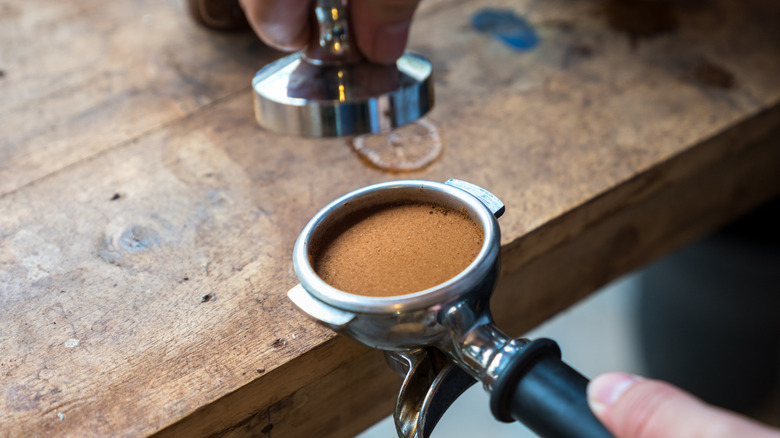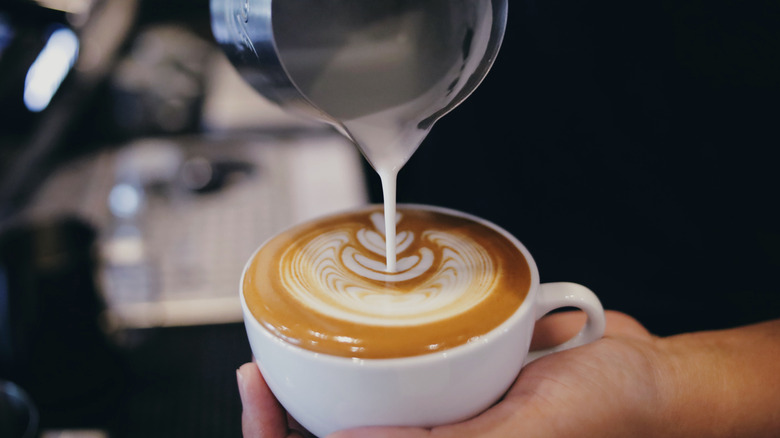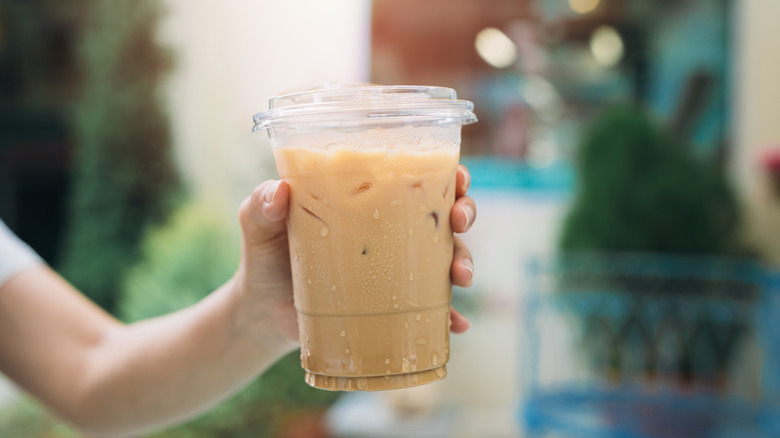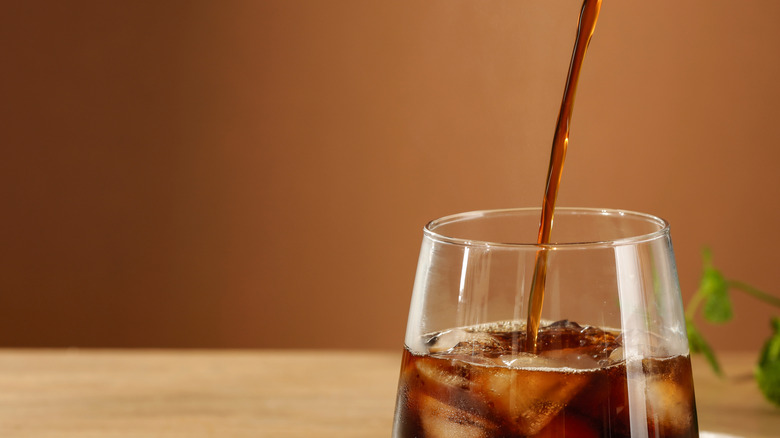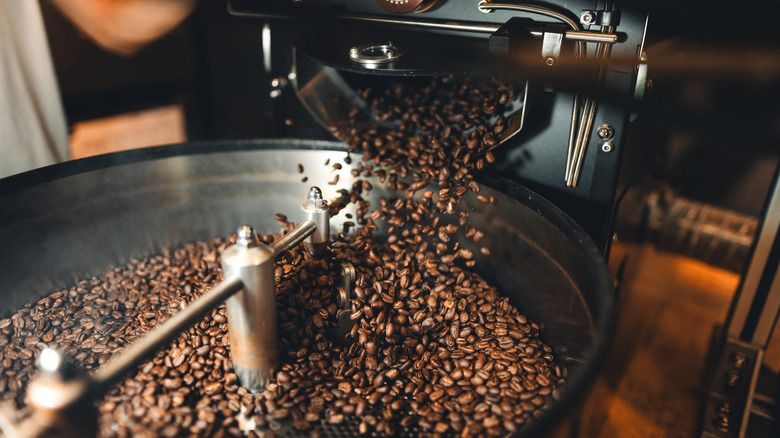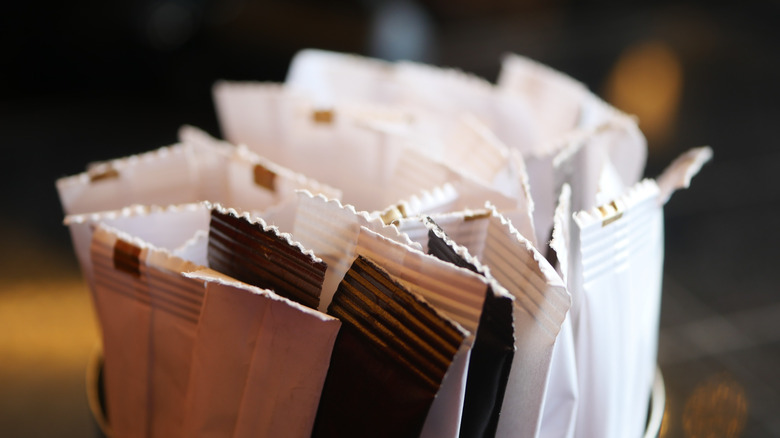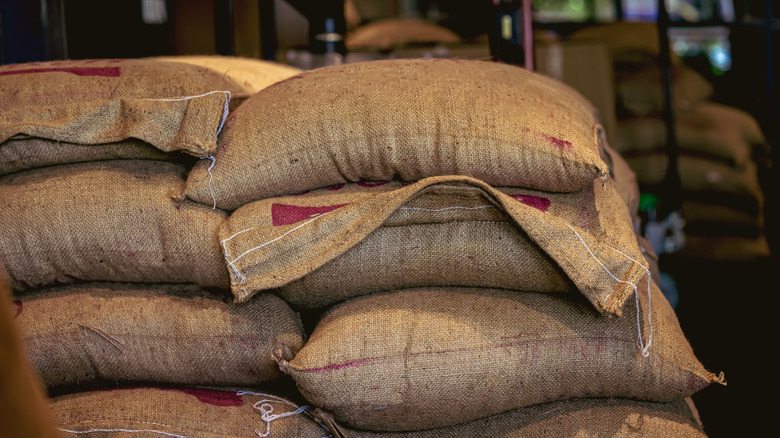13 Signs You're At A Bad Coffee Shop
A good coffee shop is hard to come by these days. I've worked in enough of them to know. Some focus too much on aesthetics rather than the coffee itself. Some chase speed instead of consistency. And some just forget what good coffee actually tastes like. The truth is, a good coffee shop takes work. And time. It's science and art mixed with hospitality and intention. I learned that after years as a barista, specifically working at two coffee shops that couldn't have been more different.
One was a massive corporate chain with tens of thousands of stores worldwide. Its focus was on quick, consistent service. The other was an independently owned, small-batch roaster where the same guy who roasted the beans would drive them across town to their four local shops that afternoon. Working in both worlds taught me a lot about coffee — not just how it's made, but how it's respected. And once you spend time on both sides, it's hard not to notice what separates the good from the bad.
From how their beans are stored to how the milk is steamed, these small details tell you everything you need to know about the coffee shop you're in. Plus, why some coffee shops are labeled the absolute best coffee shops in the US, while others fall short.
Using artificially flavored beans
There's a common misconception that flavored beans are a sign of a specialty roast — largely thanks to good marketing. Flavors like Irish cream and French vanilla sound fancy, but in reality, artificially flavored beans are one of the industry's oldest tricks for hiding low-quality coffee. Roasters will add artificial flavoring to mask high acidity, bitterness, and even staleness. And to make matters worse, artificial flavoring is added in the form of synthetic oils. These oils can cling to grinders and brew equipment, leaving a residue that can taint future brews and even damage equipment over time.
Instead of using artificial flavoring, a good coffee shop lets its beans speak for themselves. The true flavor of coffee should come from its roast method and its terroir — the environmental factors that shape the plant's character, like altitude, soil, and climate. Medium roasts, for example, develop caramel notes as the bean's natural sugars undergo caramelization during the roasting process. And coffee grown at higher altitudes tends to be more fruity and floral. When grown and roasted with skill and care, coffee beans will bring out their natural flavors without needing artificial enhancements. So, if a coffee shop smells more like candy than coffee, it's probably trying to hide something.
Crema isn't consistent
You can tell a lot about a coffee shop by the foam-like layer that sits on top of an espresso shot. That thin, lighter-brown layer is called the crema, and it's the natural byproduct of carbon dioxide escaping from roasted coffee beans when they're pressurized with water. More importantly, though, it's a sign that a coffee shop knows what it's doing.
Three things are important to note when evaluating the crema: color, viscosity, and lifespan. The color of the crema reveals how well the espresso was extracted. The viscosity refers to the texture and body of the crema, which should be rich and velvety. And the lifespan should linger for at least a few minutes before fading. Once the crema fades, the espresso starts to lose its freshness.
If you want to test a coffee shop's crema, order a single espresso and watch the top layer closely. Good crema should settle into a consistent, caramel-colored layer within seconds. It should also stay intact long enough for you to take a few sips. If it disappears after the first sip, the beans are probably stale or the barista rushed the shot.
Using unfiltered water
Simply put, bad water makes bad coffee. A cup of coffee is about 98% water, which is why coffee should never be brewed with tap water. If a coffee shop doesn't have a commercial-grade filtration system, it's already starting at a disadvantage. And good coffee shops know this.
It's common for tap water to contain things like chlorine, heavy minerals, and other impurities — all of which can dull a coffee's natural flavor and leave behind notes that taste more chemical. Additionally, when water isn't filtered, its pH levels fluctuate throughout the day. This affects how consistently the espresso is pulled from cup to cup. So pulling a perfect shot one day might be impossible the next.
Over time, all the buildup can damage water pipes and can even ruin brewing equipment. While bad water ruins the flavor and consistency of the coffee, it also creates expensive problems that hurt the shop's bottom line. Water filtration systems aren't a luxury — they're a necessity.
Uneven tamping
The art of tamping is crucial to pulling the perfect espresso shot. Tamping is the act of compressing coffee grounds with a flat tool called a tamper so they're evenly packed in the portafilter, the metal handle that locks into the espresso machine. The goal is to create a level puck of coffee beans. When done right, the water will pass through the puck evenly, extracting a balanced espresso with a rich, velvety crema. When done wrong, the water will find the path of least resistance, creating a bitter espresso with a patchy crema.
A well-trained barista will know how to make their puck perfectly level before locking it into the machine. And if it's not perfectly level, they'll know to purge the basket and start again. Because wasting a few beans is better than ruining a drink with them. When you order an espresso drink, watch your barista make it. If it looks rushed, your drink will probably taste that way, too.
Not purging the puck
Baristas at a good coffee shop purge the puck between every pull of espresso. Baristas at a great coffee shop will also run hot water through the portafilter and the group head — the permanent part of the machine where the water actually comes out of — to clear out old coffee residue before pulling another. And it makes a world of difference. When a coffee shop skips these steps, coffee residue lingers and contaminates future shots. You wouldn't use a food processor for cheese when you just used it for garlic, right? This is the same idea.
Purging the puck becomes muscle memory for a barista at a good coffee shop. And cleaning the group head becomes an oddly satisfying habit they even find themselves doing during downtime — which I know from experience. So, the next time you order an espresso drink, watch how they treat the equipment after pulling a shot. It'll instantly tell you if you should go back or not.
Making latte art with dry foam
Latte art is more than just an Instagram-worthy design. It's the proof of perfectly steamed milk. When done correctly, the milk forms a glossy microfoam — a silky, uniform layer of tiny bubbles with just enough density to hold its shape as it's poured. But all too often, it's easy to overheat the milk just enough to break the microfoam, turning that silky layer into dry, bubbly foam. Once this happens, the foam will not only ruin the drink's balance but it'll also produce latte art that nobody wants to share on Instagram.
To make sure milk isn't oversteamed, it's common for newer baristas to use thermometers in the pitchers. This helps them gauge the sound the milk makes as it steams. Sounds of a steady hiss are the sweet spot. But once that sound turns into a loud screech, it means the milk is scalding, and there's no going back.
Making iced lattes in the wrong order
Among all the ways you can mess up an iced coffee or an iced latte, there's one that often goes unnoticed: the order in which you make it. Specifically, when making an iced latte. Most people wouldn't be surprised to see a barista start by filling the cup with ice, then pouring the milk and espresso. This is one of the most common mistakes when making iced espresso drinks, though. Adding the ice should always be the last step. It seems unimportant, but it changes the drink entirely.
The right sequence matters for a few reasons. First, when espresso is added directly to ice, the ice shocks the shot. This causes immediate oxidation, and the espresso becomes more bitter — hence why the ice goes last. Second, milk acts as a buffer for the shot. It slowly cools the espresso while also preserving its sweetness and texture. You want to mix the milk and espresso before it hits the ice. Third, pouring hot espresso straight over ice immediately starts melting and diluting the shot. This breaks the crema and prevents the espresso from blending properly with the milk once it's added. It also leaves you with a watered-down drink. If your iced latte looks like it's separating into watery layers, chances are it was built backwards.
Bitter cold brew
The demand for cold brew over the past decade has skyrocketed — and for good reason. Cold brew is the smooth, low-acid alternative to iced coffee. But too many coffee shops aren't brewing it properly. Instead of a velvety richness that makes cold brew so drinkable, a bad coffee shop's cold brew will come out harsh, bitter, and flat — defeating the entire purpose of cold brew in the first place.
Unlike iced coffee, which is simply brewed hot and then cooled down, cold brew relies on time to draw out the flavors. Coarsely ground beans are steeped in cold water for 12 to 18 hours, allowing a natural sweetness to develop while keeping the acidity low. When done right, it tastes clean, smooth, and full-bodied. You should be able to sip it black without flinching. But when it's done wrong, a cold brew connoisseur knows immediately. This can happen when the grind size is too small or the grinds are oversteeped, leaving you with a cold brew that's heavy, murky, and overly bitter. If your cold brew order is more cloudy than clear, the coffee shop probably did its cold brew dirty.
Recommending dark roast when you ask for more caffeine
If you've ever asked a barista for the coffee with the most caffeine and they hand you a dark roast, you should probably find another coffee shop. The myth that dark roast coffee has more caffeine than light roast has been circulating for decades, but it's wrong. In fact, it's just the opposite. Darker roasts typically contain less caffeine than lighter ones. This is because caffeine is a stable compound that actually burns off as beans roast longer — leaving dark roast coffee tasting more intense, but not more caffeinated.
In fact, caffeine content can vary widely from one cup to another, and you'd want your barista to know that. When a coffee shop is confusing the amount of caffeine in their brews, it's a clear sign there's a gap in coffee knowledge and training. The next time you head to a coffee shop for a much-needed pick-me-up, go for a breakfast blend. There's a reason they're called breakfast blends, after all.
A messy condiment bar
In my hospitality classes in college, the first thing I learned was that cleanliness is the first (and most important) form of respect. It's how you tell a guest or a customer that they're not only welcome but valued and appreciated. If a place ignores what's most visible, it makes you wonder about what's hidden. So the cleanliness of a coffee shop can tell you a lot — especially how clean and stocked the condiment bar is. I'm not saying someone should constantly be wiping up spilled milk, but a routine refresh should be mandatory during rushes.
The best coffee shops make cleaning the condiment bar part of their daily tasks. During any given shift, one person should know that they're the one responsible for wiping and restocking the station. A well-kept front of house tells you everything you need to know about the standards of the back of the house — even at a coffee shop.
Storing beans incorrectly
Coffee is a fresh food product. And just like any fresh food product, it starts losing quality the moment it's pulled from the roaster and exposed to air and light. Oxygen and sunlight are coffee's biggest enemies. They dull the flavor, break down the natural oils, and mute the nuance of every bean. That's why proper storage matters. Coffee beans should be kept in airtight containers, away from heat, light, and moisture. If they're not, the beans age faster and the coffee tastes lifeless. A coffee shop tha5proudly displays its beans in open bins or clear glass jars is prioritizing aesthetics over freshness.
There are so many mistakes people can make when storing coffee beans. And it's a huge red flag when a coffee shop is making those mistakes, too. The next time you walk into one, check how their beans are stored. If you can see the beans through the glass, they're already starting to go stale.
